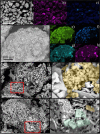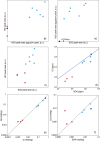Atmosphere injection of sea salts during large explosive submarine volcanic eruptions
- PMID: 37660204
- PMCID: PMC10475066
- DOI: 10.1038/s41598-023-41639-8
Atmosphere injection of sea salts during large explosive submarine volcanic eruptions
Abstract
The 15 January 2022 submarine eruption at Hunga volcano was the most explosive volcanic eruption in 140 years. It involved exceptional magma and seawater interaction throughout the entire submarine caldera collapse. The submarine volcanic jet breached the sea surface and formed a subaerial eruptive plume that transported volcanic ash, gas, sea salts and seawater up to ~ 57 km, reaching into the mesosphere. We document high concentrations of sea salts in tephra (volcanic ash) collected shortly after deposition. We also discuss the potential climatic consequences of large-scale injection of salts into the upper atmosphere during submarine eruptions. Sodium chloride in these volcanic plumes can reach extreme concentrations, and dehalogenation of chlorides and bromides poses the risk of long-term atmospheric and weather impact. Salt content in rapidly collected tephra samples may also be used as a proxy to estimate the water:magma ratio during eruption, with implications for quantification of fragmentation efficiency in submarine breaching events. The balance between salt loading into the atmosphere versus deposition in ash aggregates is a key factor in understanding the atmospheric and climatic consequences of submarine eruptions.
© 2023. Springer Nature Limited.
Conflict of interest statement
The authors declare no competing interests.
Figures






References
-
- Cahalan RC, Dufek J. Explosive submarine eruptions: The role of condensable gas jets in underwater eruptions. J. Geophys. Res. 2021;126(2):e2020JB020969. doi: 10.1029/2020JB020969. - DOI
-
- Kokelaar BP. The mechanism of Surtseyan volcanism. J. Geol. Soc. 1983;140(6):939–944. doi: 10.1144/gsjgs.140.6.0939. - DOI
Grants and funding
LinkOut - more resources
Full Text Sources
Research Materials
Miscellaneous

